"You will win, but you will not convince"
Few figures in recent Spain have created as much controversy as that of Millán-Astray. Was he a military fanatic demonized by public opinion or was he a staunch defender of the interests of Spain? His story is really amazing.
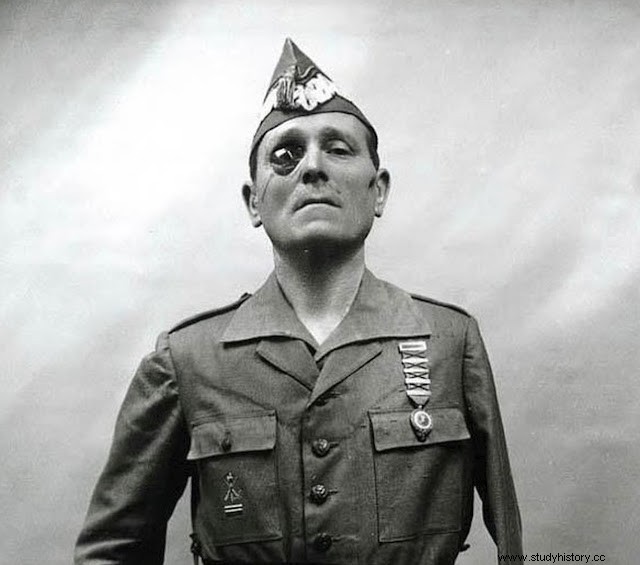 Millán-Astray
Millán-AstrayBorn in La Coruña on July 5, 1879 within a family wealthy and educated middle class. His father, although he wanted to be a soldier, was a lawyer, columnist, author of zarzuela librettos and, as a State official, he held different positions in various ministries. He had an older sister, Pilar Millán Astray (1879? -1949), who was a very popular writer and playwright of her time, with works like La tonta del boat , and directed the Muñoz Seca Theater, and also worked spying for the German secret services in Barcelona.
At the age of 15, on August 30, 1894, he entered the Toledo Infantry Academy, where he followed the abbreviated study program arranged by the Government to attend to the needs of officers of overseas conflicts (Cuba and the Philippines), graduating with just seventeen years as a second lieutenant and later serving in the Asturias Infantry Regiment No. 31 Madrid. On September 1, 1896, he entered the Escuela Superior de Guerra, where he interrupted his studies to join as a volunteer an expeditionary battalion sailing for the Philippines. During his stay in the islands he is distinguished by his courage, especially for his performance in defending, at the age of 17, the population of San Rafael with thirty men against a much larger number of Tagalog rebels.
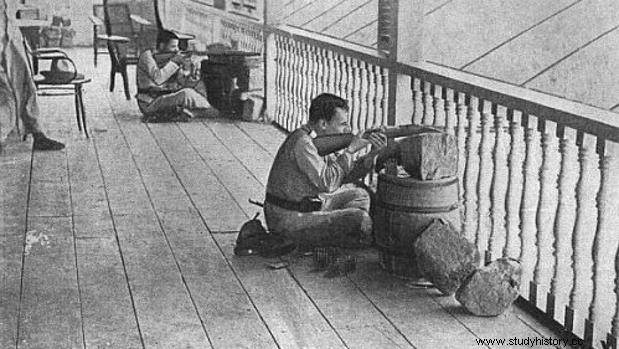 Spanish soldiers during the Philippine revolution
Spanish soldiers during the Philippine revolutionFor his participation in the combats he received two 1st Crosses Class of María Cristina, the highest decoration for valor at the time, and two others for Military Merit. In July, he was posted back to the High School. During the long trip back, according to his account, the idea of forming units framed by professional soldiers began to germinate in him.
In 1905 he was promoted to captain in Madrid, where he met and married Elvira Gutiérrez de la Torre, daughter General Gutiérrez Cámara; They had no children. The following year, obsessed with the General Staff, he asked to re-enter again.
For the third time he returned to the School, finished his studies, did two years of internships, among which his work in the Spanish-French topographical commission for trace the border and obtained the diploma of General Staff. In 1911 he made a decision that marked his career, appointed professor at the Infantry Academy, he resigned from the General Staff Corps to continue in his Arms of origin. A year later he was stationed in Melilla.
In 1913, before the general attack of the Raisuni men in Yebala, he was transferred to the Tabor de Regulares de Arcila, in the Larache Command, then commanded by Colonel Wild Fernandez. In the campaign he stood out to full satisfaction, rising to commander for war merits. He was 35.
Battles of Hispania Official Store
Once the operations were over, he returned to Madrid, in 1917, to the Savoy Regiment No. 6. There he developed a tireless professional and intellectual activity. The experience of commanding conscript soldiers in combat with hardly any training made a large number of professionals want Spain to follow the French example with the Foreign Legion and indigenous units. The Army already had indigenous Police and Regulars, but a shock force was needed. Politicians, faced with social pressure, were predisposed to accept initiatives that would save sending fifth-class soldiers to Africa. Millán Astray, seeing the opportunity, became an active propagator through letters, talks and articles, of the need for a mercenary force.
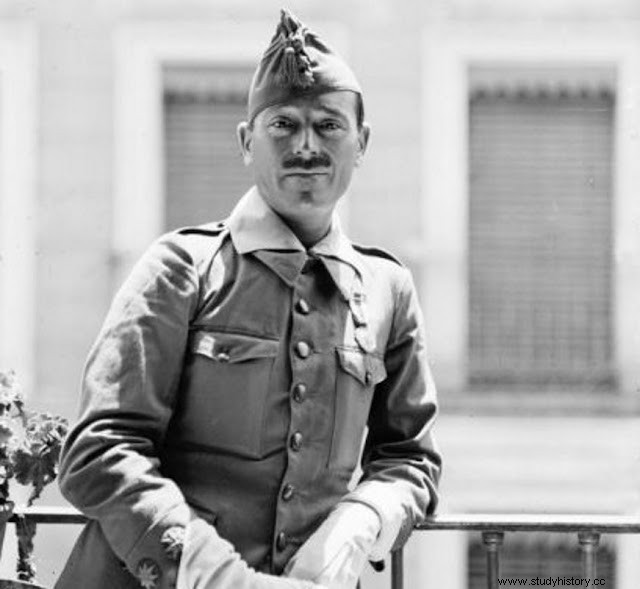 Millan-Astray even without his war wounds.
Millan-Astray even without his war wounds.In the year 1918 he was modeling the project, which he spread not only among colleagues but also to superiors such as Berenguer and Fernández Silvestre, then His Majesty's aide-de-camp. There was general agreement with nuances. Silvestre, for example, wanted volunteers but only Spaniards. In the shooting course for chiefs, held at the Valdemoro Central Shooting School, he spread his ideas. Commander Francisco Franco, also concurrent, promised him for the future corps of volunteers.
He did not stop until he managed to meet with the Minister of War, General Tovar, whom he convinced. During the month of October 1919 he was in Tremecen and Sidi-Bel-Abbes (Algeria) living as one more officer among the French legionnaires. On January 28, 1920, the King signed the Royal Decree that created the Tercio de Extranjeros, but due to a crisis the Government ceased, and the new minister, General Villalba, shelved it; there was another crisis and the replacement, Viscount Eza, after listening to a vibrant conference on the Tercio by the recently promoted Millán Astray at the Military Casino, decided to launch the project which, with some variations, today endures under the name of Spanish Legion.
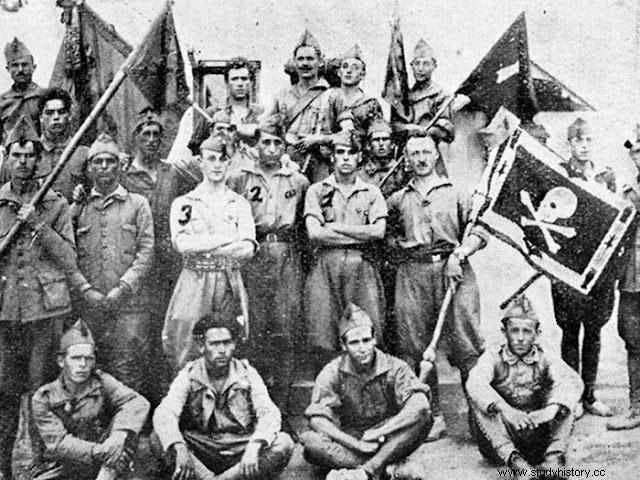 Third of foreigners
Third of foreignersThe code of the new unit was the Legionary Creed, based on its own creator , in Bushido, the moral code of the samurai.
Millán Astray wanted to create a unit well prepared for combat. The Tercio did not enter combat until after more than six months of training.
The Flags of the Tercio, with this magnificent preparation, were Berenguer's fundamental asset that prevented (1921) the fall of Melilla into the hands of Abd el Krim and then the spearhead with which he pushed the Rif people back. The fame of his boss, who received the individual Military Medal, spread inside and outside of Spain.
On September 17, he received a bullet in the chest, the King congratulated him and named him a gentleman of the Chamber in January, the on the 10th, the second, this time in a leg.
The defense committees determined his dismissal as head of the Tercio, leaving him available in Madrid. Millán-Astray reacted with a manifesto published in El Liberal against the boards and threatened to request discharge from the Army. Nothing happened thanks to the mediation of the King.
Undoubtedly, the dismissal had more significance than a simple change of command. The appointment of Lieutenant Colonel Valenzuela provoked the immediate request for the appointment and departure of Commander Franco, head of the 1st Bandera del Tercio, disappointed for considering himself the logical successor as he was proposed for promotion. Valenzuela died a few months later in the extremely harsh combats of the Tercio in Tizzi Azza and Franco, recently promoted, replaced him. The story would surely have been different if he had been in his place or if Millán had continued to command the Tercio.
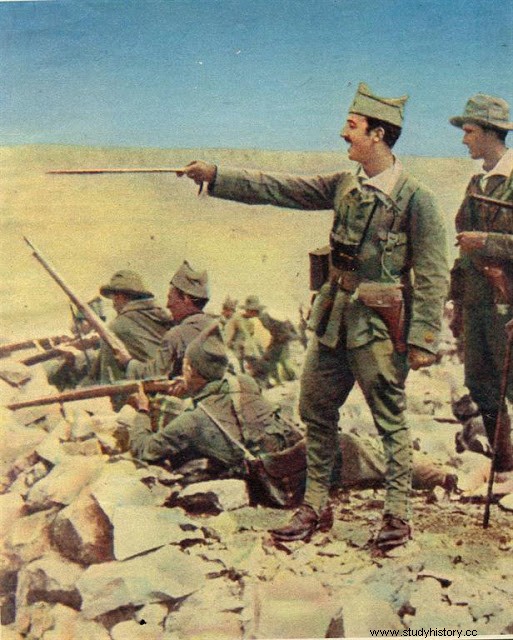 A young Francisco Franco leading troops in the war in Africa
A young Francisco Franco leading troops in the war in AfricaPrimo de Rivera, coming to power he rehabilitated him by placing him under his direct orders in Africa, promoting him to colonel for war merits. In the first operation in which he participated, on October 26, 1924, he was wounded. Two days later, due to the presence of symptoms of gangrene, his left arm had to be amputated.
On February 1, 1926, he was allowed to return to active service, being given command of the Tercio which, ironically, was handed over to him his former subordinate, the recently promoted Brigadier General Francisco Franco Bahamonde.
He had not yet been in Africa for a month, when on March 4 he was given command of one of the columns organized in the operation on Bu-Zeitung, Mount close to Tetouan, from where a cannon persistently fired on the city. As soon as the combat began, he received a bullet in the face that destroyed his right eye. Far from meeting his death, a year later he was promoted to general by merit, naming him honorary colonel of the Tercio.
 Millán Astray with his visible war wounds
Millán Astray with his visible war woundsHis military life had few horizons, mutilated and lacerated Due to so many injuries, even so, he was appointed head of the Ceuta-Tetuán Circumscription, after a transitory stint in the ministry as head of the 2nd Section of Recruitment and Doctrine. In these years he prodigious himself as a lecturer not only in Spain, but also in France, Italy and America.
With the arrival of the Republic, by Decree of August 10, 1932, he forced himself to the situation of second booking. The presence among the advisors of the Minister of War, Manuel Azaña, of former members of the extinct Defense Boards is one of the causes, the other seems to be that he knew of the Sanjurjo conspiracy of August 10.
In 1934 the prime minister, Alejandro Lerroux, who had been a friend of Millán's father, appointed him secretary of the Supreme Council of the Ministry of War, a bureaucratic and unimportant but prestigious position.
After the election of the Popular Front, at the request By decree of May 11, 1936, he was granted admission to the Corps of Military Invalids. When the military uprising took place on July 18, Millán Astray was giving lectures in Buenos Aires, Argentina.
When the Civil War broke out, Millán Astray, as soon as he could, moved to Spain, placing himself unconditionally at Franco's disposal. With his body physically destroyed, he was no longer good enough to command military forces in the field, but he carried out active propaganda work, both for the regime and to raise the morale of the troops on the front lines. With his personality and imprint, he carried out these tasks perfectly.
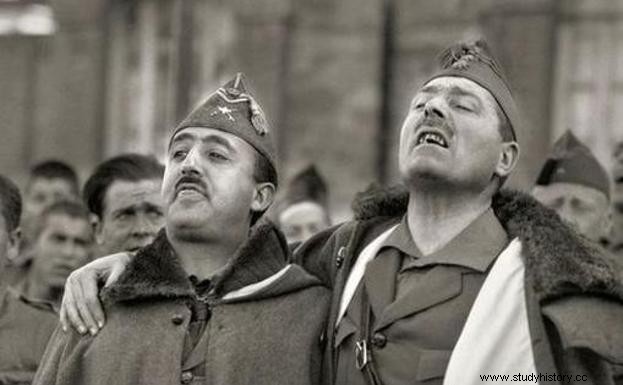 Millán Astray and Franco during the civil war
Millán Astray and Franco during the civil warAt the express wish of Franco, he formed the Corps of Mutilated by Homeland; he fulfilled the assignment giving evidence of his practical sense and organizational capacity.
After the war, Franco rewarded his loyalty by appointing him attorney in Cortes (1943) but gradually his activities languished. Even so, he continued to be a well-known and popular character, starring in anecdotes such as his participation as best man at the wedding of the singer Celia Gámez:faced with the difficulties caused by the massive influx of public, he shouted his famous harangue "To me the Legion!" to allow the bride access to the altar.
He died at the age of seventy-four, at ten o'clock at night on January 1, 1954, at his home in Madrid, due to coronary disease, being general director of the "Corps of Mutilated Knights of War for the Fatherland". His doctor, Mauro José Rodríguez Rey, a personal friend and pupil of Millán-Astray in the Legion, was in charge of informing Franco himself. He was buried in the Almudena cemetery.
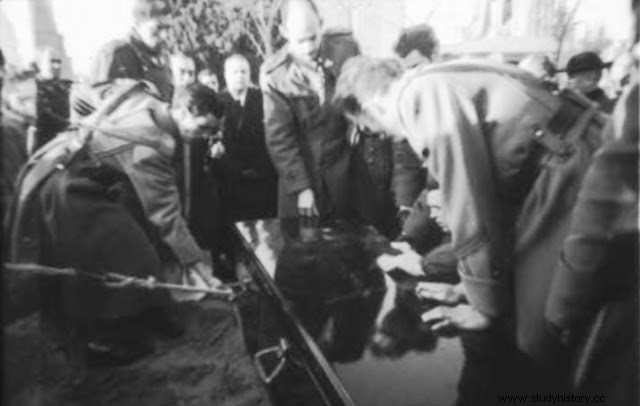 Millan Astray burial
Millan Astray burialWar wounds, "the enemy of the death"
During the war in Morocco he suffered four serious injuries:
-The first occurred on September 17, 1921 in the Amadí ravine, where he was wounded in the chest when he was giving orders for the capture of Nador .-The second on January 10, 1922 after the battle of Draa-el Asef, where the "Gómez Arteche blockade" was established. When he was relieved by Lieutenant Colonel González Tablas, he was wounded in the leg while he was leaving.-The third happened on October 26, 1924 when, promoted to colonel and on his way to the Fondak of Ain Yedida to take command of the "column R' gaiga", found the road blocked by enemy fire. When he approached the front line to harangue the soldiers of the Burgos Battalion, he received a shot that destroyed his left arm. Said arm was later amputated when gangrene was diagnosed.-The fourth wound was suffered on March 4, 1926 when he was in command of a column, engaged in combat with the enemy and managed to take "Loma Redonda", giving orders to fortify it . While examining the first positions he was shot in the face that destroyed his right eye and caused tears to his jaw and left cheek. Because of this injury he lost said eye and would suffer from vertigo for the rest of his life every time he turned his head.
"You will win, but you will not convince"
It is a famous quote attributed to Miguel de Unamuno, writer and philosopher of the generation of 98, on October 12, 1936 in the auditorium of the University of Salamanca, during a ceremony of what was then called the Fiesta de la Raza, anniversary of the discovery from America. The ceremony was attended by Franco's wife, Carmen Polo de Franco, the Africanist general Millán-Astray, the bishop of the diocese Enrique Plá y Deniel, José María Pemán, the military governor of the square and the rest of the active forces of the city. The event was opened by Unamuno and was broadcast on local radio.
The criticisms and threats made to all those who did not share the ideals of the uprising, condemned as anti-Spain, among other points, were what caused the rejection of Miguel de Unamuno who delivered a speech criticizing the attitude towards the civil war and the role of Catalans and Basques with respect to Spain.
Millán-Astray, located at one end of the presidency, hit the table with his only hand and, getting up, interrupted the rector —«Can I speak?, can I speak? »– His escort presented arms and someone from the audience shouted:« Long live death! ». Historiography cannot determine if the military intervened then and if that was the moment when he shouted:Death to intellectuals! Long live death! . After the proclamations of:one, great free! , Unamuno continued his speech charging directly against Millán Astray:"This is the temple of the intellect and I am its supreme priest. You are profaning its sacred precinct. Whatever the proverb says, I have always been a prophet in my own You will win, but you will not convince. You will win because you have plenty of brute force, but you will not convince because convincing means persuading. And to persuade you need something that you lack in this fight, reason and right. It seems useless to ask you to think of Spain"
After his speech, several officers reached for their pistols, while Unamuno left the auditorium protected by Carmen Polo de Franco, who offered him her arm, and by other personalities, while he was rebuked with insults and boos, to mount in a car that would drop him off at his residence on calle deembroideres in Salamanca.
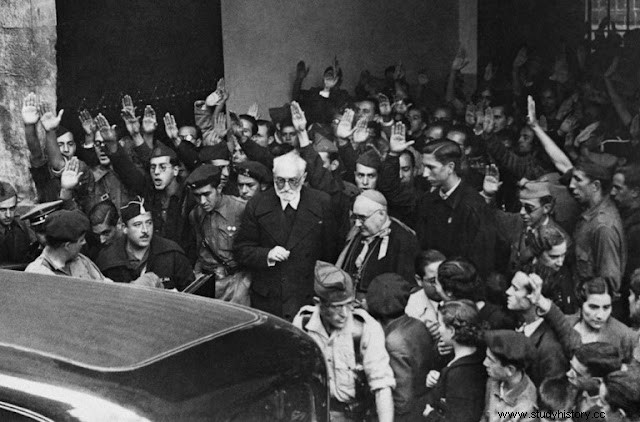 Unamuno fleeing the compound by car
Unamuno fleeing the compound by carThis act would cost Unamuno the last months of his life, from October to December 36, under house arrest at home.
Recreation of the event.
